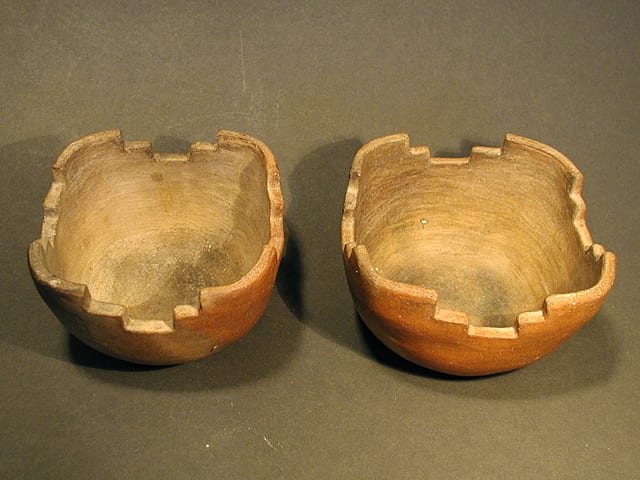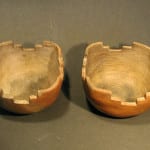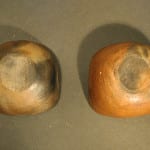The bowls have a squared-off shape, with rounded corners. These bowls may be similar to the bowls (“na ku yipi”), Alexander Stephens observed holding water and boiled medicine in Hopi kivas in the 1890s (Stephen, 1936: 42, 48, 572-73, 739,743 and 845, among others). The four terraced motifs represent rain clouds from the four cardinal directions (Kenagy, 1990, notes). Curtis (1922:111), describes a similar bowl. He does not give a specific citation, but often refers to Fewkes, who took much of his material from Stephens without attribution.
The stepped rims, squared shaped, and lack of design is in line with the discussion of “medicine bowls” by Suzanne Kenagy at the Recusoe de Santa Fe pottery conference, October 19, 1990. According to Dr. Kenagy’s dissertation, “in many pueblos pottery used in the most sacred and secret contexts was undecorated. Pots bearing symbols such as clouds, tadpoles and terraced rims were often used only in the public portion of the ceremonies, to signal the presence of power to uninitiated people. Full initiates did not need pottery that visually signaled the sacredness of the situation.” (Kenaghy as summarized by Hays in Schaafsma, 2000: 51) Judging from Stephen’s (1936) descriptions of Hopi ritual terraced bowls were a common element in Hopi and Hopi-Tewa kiva rituals in the 1890s.
A rectangular medicine bowl without crenellated edges and with limited, simple, interior decoration is also part of the collection (1992-10). Such rectangular bowls without terraced rims were found by Fewkes in his excavation of Sikyatki (Fewkes, 1973:44 facing and 77). Terraced painting frequently was found by Fewkes on Sikyatki pottery (1973:155) and can be seen on the exterior of a Jeddito pot in this collection (1994-15). However, Fewkes found no Sikyatki bowls with terraced edges during his excavations. Writing in 1919, he says that the “modern” medicine bowls of “rectangular terraced form which (are) common…were probably lately introduced into Hopiland by those colonists of alien clans who came after the destruction of Sikyatki (1973:154).” These “colonists of alien clans” were the Tewa who arrived at Hopi in about 1700 and from which Nampeyo is directly descended. Apparently by the time of Stephen’s work (1894) the use of terraced medicine bowls in kiva ceremonies had spread to at least the Hopi of First Mesa. Thus, if Fewkes is correct, the somewhat squared form of 2005-17 and 2005-18 represent an ancient medicine bowl tradition at Hopi, but the terraced edges may be an adaptation from the Tewa that occurred after 1700. (For a modern Hopi-Tewa terraced bowl, see 2000-01.)
A prehistoric (ca. 1200-1400 CE) ceremonial bowl from the M0gollon Culture with stepped rims is illustrated in Peckhan (1990:117): proof that outsiders may know relatively little about the sequencing of forms of medicine bowls. As it should be..
Writing of the Zuni, Edmund Ladd concludes that “objects that are considered to be sacred are sacred only in the function of the ceremony. For example, the cloud bowl [like 2005-17 and 2005-18]…with corn meal in it…Once the cornmeal is used up and its ceremonial use is over, it’s put on a shelf and it’s no longer sacred…It becomes a decorative object (Schaafsma, 2000: 20).” Given the close cultural ties between Zuni and Hopi, this may be the understanding at Hopi also.



